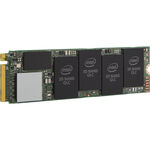QLC + Dram, really good price especially if you're buying more than 1
Intel 2TB 660P NVMe M.2 Internal SSD US$99 (~ AU$147) + Delivery & GST @ B&H Photo Video
Related Stores
closed Comments

Saved you a click…
DHL Global Mail (10-12 Business Days) - $17.00
DHL Express (4-7 Business Days) - $22.51
FedEx International Priority (3-5 Business Days) - $49.80Subtotal: $99.99
Shipping: $17.00
Duties & Taxes: $11.70
Total: US$128.69~AU$190.60

A big price difference between DHL Express and FedEx. For a little tiny item it's crazy. No one in the right mind is going to pay that much for FedEx just to get it a day or two sooner. It's over twice as costly. Unbelievable hey.

They offer NYC pickup too if anyone happens to be there.

Hoping I can get a NYC return flight for $49.80..

Definitely worth a visit to the store if you're ever in NYC. The conveyor belt system from the service counters to the checkout was oddly impressive

PSA: 660p not recommended
Besides being the same - if not more expensive - per $/TB than 1.5 years ago, Intel's SSD business was so bad they had to sell out to SK Hynix so this drive is actually now supported by the new company Solidigm
QLC and 400TB endurance make the 660p suspect value when you can regularly get the Crucial P3 with better TBW (440TB) and Amazon warranty/returns for $90/TB like here and here

That's double standard. Given that you posted BX500 deals and your table of SSDs with DRAM are generally a tier above, it gets confusing. Also 400TB vs 440TB TBW, frankly is not a huge difference.
Honestly, if we are talking about QLC SSDs, then price is a factor. No matter how you want to spin this, at the discounted price, it is still cheaper than the P3 deals. Problem with P3 is that at that price point, it faced tough competition from a deal you posted (SN570 2TB) and local NV2 2TB (though that one does have a huge lottery gamble so there is no guarantee you won't get QLC for NV2).
Though its general performance is mostly only better than SATA SSDs, Intel did ensure the QLC sustained write bit doesn't suck that bad (175MB/s is respectable for QLC, compared to P3's 100MB/s due to far too aggressive pSLC and heavy recovery). P3's DRAMless controller does perform better and Intel's DRAM approach on this SSD is iffy (but hey, Crucial plays the same trick on some of their SSDs as well).

@netsurfer, you're trying too hard
You did read krouton24s +50 comment right? Right?
This 660p comes to ~AU$190, more than the P3 examples given above
Everyone on OzBargain would benefit if you put in as much effort to sharing some nice SSD deals - which you are clearly knowledgeable about - rather than shoot off long winded comments and e-flexing
Have a Happy New Year

The thing is, based on your general standard, a QLC SSD with DRAM trumps QLC SSD without DRAM. So now, you are going to break that trend?
Tier Spec Recommended Usage 3 QLC + DRAM Secondary storage, can be main system drive in very cheap build 4 QLC + no DRAM Secondary bulk storage only So, the aspect that makes this SSD's DRAM better than P3 (based on your usual table) is no longer relevant? If you look at the majority of the benchmark results, you get the feeling P3 is better, but as usual, the DRAMless issue persists. Basically, I like to know your view on that. Because, I am confused, the one area where this Intel QLC SSD beats P3 does appear to be DRAM related. Or, in this particular case, we just ignore that and look at SLC cache?
My issue is neither P3 nor this is a good deal. As for posting SSD deals, you guys are just faster than me and at times, it is best deal at the moment gets posted. Also, when you posted the P3 comment, P3 isn't available at that price.

Would this be okay for a boot drive ? My 1tb silicon power drive just died, or suspected dead.

Following…
.

Do you need Dram though? My last ssd lasted 2-3 years and I would like to think with a Dram that it would last longer ?

Nope. The part that fails in an SSD is almost never the cache.

Warranty?
I just had a silicon power drive fail. The RMA process is a bit of a pain, requiring sending it back to Taiwan

@ihfree: mine literally failed just now, within a month of purchase.
Back to Umart i'll go early next year and throw it at them - requesting a full refund

Honest question - Why wouldn't it be OK for a boot drive?

Good question. More so is it overkill for a boot drive. I assume these drives are more intended for moving big files and for content creators.

I think QLC SSD aren't very good at moving big files. As in it will end up slowing down to slower than a hard drive when writing large files to it when the cache is exhausted.

Your boot drive is often also your pagefile drive. Pagefile gets thrashed quite hard and so 400TBW is pretty suspect

pagefile used to be an issue in the old days when people had little ram , windows 10 and office apps load in in under 8gb so if you have 16gb you might want to check as most of your apps might be running in ram. also dram vs no dram on an ssd, some manufacturers depend on using some of the ram on the motherboard as cache depending. how windows is setup. i’m amazed how much free memory i have on my 16gb pc after i load windows, office apps and visio ….. i haven’t noticed performance increases as my ssd has gone from the older samsungs to now the 980pro….. guess it depends on your workloads

@garage sale: Absolutely depends on your workloads.
For stable office usage, you can probably disable the pagefile entirely (with 32GB of physical RAM for example).For gaming usage, some unstable games are made more stable with pagefile enabled, regardless of available physical RAM.
If pagefile is enabled, then it gets thrashed, meaning that drive's TBW is getting wasted every day, especially if the PC goes into sleep or hibernate mode, etc.
@thlunasa: TBW numbers are gigantic though, you're not going to get anywhere near them just doing "normal" things, even including hibernation and page file.
Go and look at the numbers on your existing SSDs - even my heaviest used drive (a Samsung 860 QVO) has only used 21% of it's lifetime writes over the past 3 years ! At this rate it has well over ten years of life remaining, and this drive gets a serious workout.
None of my other drives have even got below 90% yet….

It is okay / fine for a boot drive. The main thing is majority of people won't recommend it. All those arguments are subjective though.
- Should get a TLC for a system SSD. Reality is that NVMe SSDs are overkill for most people. Sure, file copying can be a lot faster. Problem is from where to where? If that's really a big factor, then we should all get PCIe gen 4 SSDs.
- 2TB is too big for a system drive. Problem is, there is nothing wrong with getting a large SSD for system SSD (you could partition it to multiple drives if you want). Furthermore, for QLC, it is a good idea to get 2TB (otherwise, the sustained write drops even further). It's due to 2TB, Intel managed to make this SSD's sustained write 175MB/s, which is actually pretty good for a QLC.
- There had been or there are better options which just cost a bit more. Well, QLC SSD deals are not going to be amazing. However, if you are after a great SSD deal, this is not it.

I had as a boot drive and swapped it out.
Boot speeds were fine but it was a little sluggish on desktop usage compared to even some SSD 3.0’s I previously used.
Using it now as game/photo drive secondary drive and it’s good for that.
Sustained reads are in the toilet but for most things it’s good enough.
Yea honestly everyone deserves ssd speeds nowadays not just content creators

It is fine for a boot drive. The reason is simple. While it is slow for a NVMe SSD, it is still faster than SATA SSDs (in general usage).
https://cdn.mos.cms.futurecdn.net/2gpD4sgYjMAhnYwx83Hs7J-970…
It loads games faster than 860 EVO. Obviously, 860 EVO has a better sustained write so once the SLC cache is depleted, this QLC SSD will write slowly (for a SSD). However, in your case, I hope your Silicon Power SSD is still under warranty.

I want to say the SP is three years old so I doubt it.

I only have one SP SSD. My one came with 5 year warranty…. but… now, where did I keep the receipt?

This chart is a great example of why SSD performance just doesn't matter for most people - discounting Optane, there's only a 4 second gap in load times between the fastest SSD and the slowest SSD !!
"Slow" SSDs are absolutely fine for normal use - what's important is that they are SSDs instead of mechanical drives.

I've had my Intel 660p 2TB for around 3 years and 7 months now and it's still going strong, no issues at all. Mainly used as a storage drive.

QLC 🤢

Silicon Power 2TB is $179.99 with 1200 TBW.

Is this good for PS5 storage? I was trying for a Samsung 980 PRO and that's around $200~ for 1TB.

Nowhere near good for a PS5. It can't even see 'good for PS5' from where it's standing.

You could have today got it for $171.44 delivered. It's one of the SSD confirmed for PS5 compatibility.

It's only a PCIe 3.0 SSD. PS5 requires a PCIe 4.0 SSD. So no it's not compatibile with the PS5.

Right now, if you don't care about speed and price is the main factor. You could cheat and get NV2 2TB for $189.
- Don't get it from Amazon, because NV2 is a lottery. There are 4 versions (2 different controllers and TLC, QLC variants).
- Amazon NV2 2TB, some users have confirmed they received QLC ones. It's quite difficult to get 2TB TLC version from US and Canadian retailers.
Honestly, the best PS5 deal so far was probably 2TB WD SN850X (with heatsink) for $287. NV2 works with PS5 (it is below the recommended speed though), even if you ended up with the QLC version, though I would seriously avoid the QLC version (mainly because if if is QLC, I would want it to be $140 or lower for 2TB). NV2's 3 year warranty is also not desirable.


Gee this is damned cheap. It's a QLC SSD though so sustained write speeds will suffer.